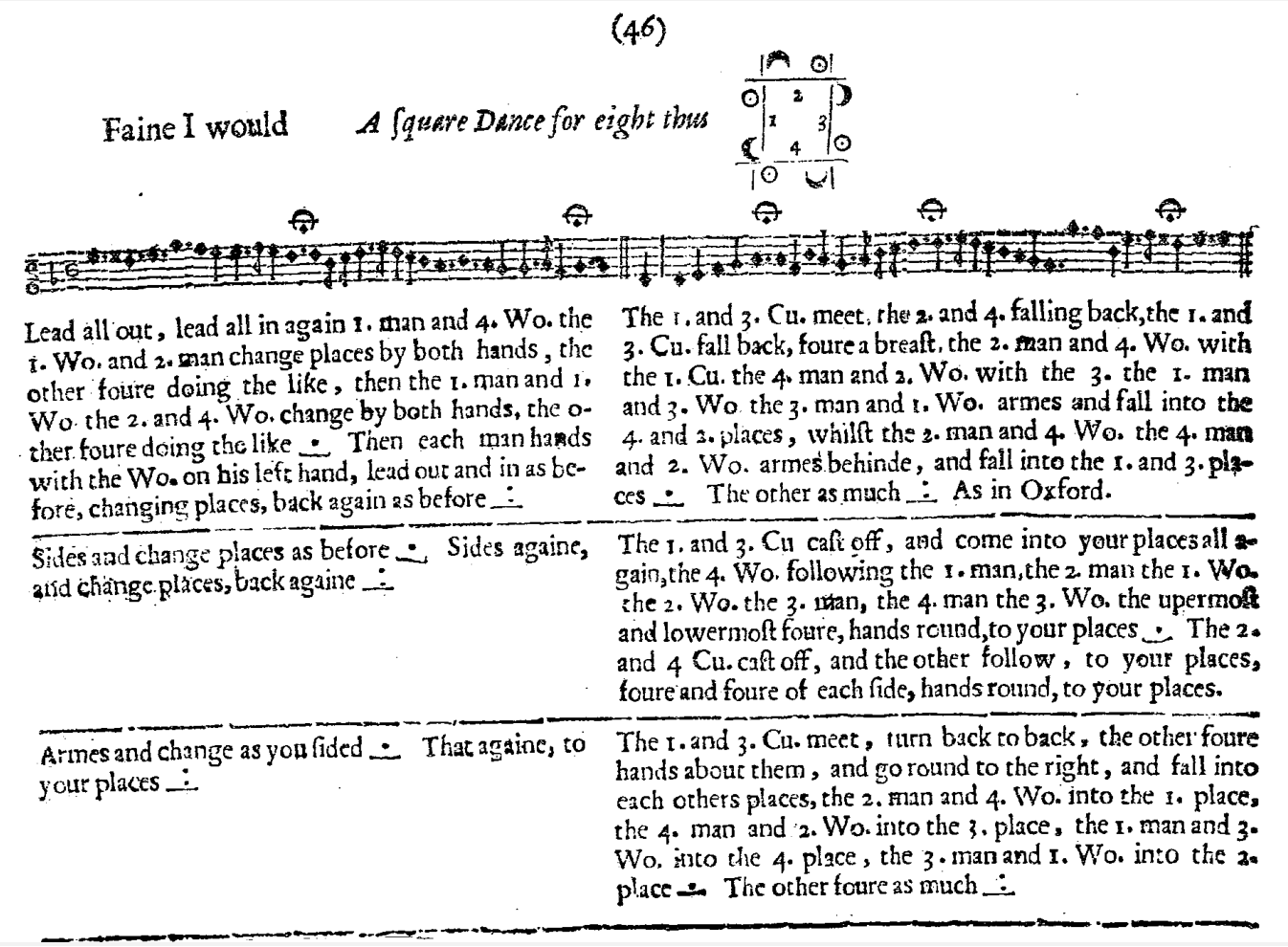Published as "Faine I Would if I Could" in first edition and "Parthenia, or Faine I Would" from the fourth edition, this is a fairly complex display dance. I think it should have the couples starting improper and facing out; apparently I'm not alone in that but here's a bit of an explanation why that hopefully some people will find interesting. Otherwise what I do is pretty similar to other people, and in the main it makes no difference to the actual dance which way round you are with your partner, so if you're not worrying about gender anyway then this is all irrelevant!
I see Colin Hume's put a lot more thought into how to call this in his description than I ever could and makes good use of the term "shadow", which I'm going to copy here as it makes things a lot clearer. I think the only differences between these two descriptions, other than the starting position, are doing an arm R both times in the part 1 figure, and the circle right for the first half of the part 3 figure (due to starting improper).
Your shadow is your original opposite across the square.
Start facing out next to your partner, men on the left and women on the right (if dancing gendered).
| Part 1 | |
|---|---|
| A1 (8) | Lead out a double, turn around and lead back (4) Turn your corner about halfway (⅜ or ⅝ as needed) to face across the set in two lines (2) Turn the person you're facing halfway into a new square set facing out (2) |
| A2 (8) | Lead your shadow out a double, turn around and lead back (4) Repeat second half of A1 home, finishing facing in |
| B1 (8) | Heads come forwards as the sides retire a bit into lines of 4 facing up and down (2) Lines of 4 fall back (2) All arm R your shadow, heads to the nearest side place and sides behind them to the nearest head place (4) |
| B2 (8) | Repeat B1 from new positions |
| Part 2 | |
| A1 (8) | Partners side R (4) As part 1 (4) |
| A2 (8) | Shadow side L (4) As part 1 (4) |
| B1 (8) | Head concentric casts: Heads cast through nearest side places and lead back home while sides, working with their shadow, lead into nearest head place and cast back home, finishing close to shadow (4) Circles of 4 at top and bottom of the set (4) |
| B2 (8) | Side concentric casts (4) Circles of 4 at the sides (4) |
| Part 3 | |
| A1 (8) | Partners arm R (4) As part 1 (4) |
| A2 (8) | Shadow arm L (4) As part 1 (4) |
| B1 (8) | Heads come in and stand back to back (2) Sides take hands in a circle and circle right around the heads, finishing in the nearest head place to where they started (4) Original heads lead out to nearest side place (2) |
| B2 (8) | Repeat from these places, the circle going left. |

I think that this dance starts with the men and women improper and facing out (i.e. the man on the left and woman on the right when facing out, not when facing in, for several reasons:
- In first edition, in the set diagrams, moons are men and suns are women. This diagram has them the other way around from normal!
- Aside: In 3rd edition the table of abbreviations and symbols at the front swaps the meaning of the suns and moons (presumably to match more normal conventions in society) but almost none of the dance diagrams are changed, so I largely ignore that change to the table (see "suns and moons" in interpretation guidelines). The exception is Faine I Would, which is changed and now matches the other squares. So you need to look at earlier editions to see this.
- If you follow the instructions and assume the dancers start in the normal proper places, the instructions don't work. Right from the start, it says lead all out, lead all in again 1. man and 4. Wo. the 1. Wo and 2. man change places by both hands – but those people aren't anywhere near each other. If the dancers start improper, the instructions work.
- The dance starts with a lead out. So why shouldn't the dancers be the normal way around for the direction they actually start facing?
In the first half of the first chorus, there's a typo: the 2. and 4. Wo change places should be 2nd man and 4th woman.
At the mid-point of the chorus, Playford says Then each man hands with the Wo. on his left hand, lead out and in as before – does he mean the woman on the man’s left hand as he faces out, or as he faces in? If the former then it’s your corner, who you dance quite a lot with already, but if the latter then it’s your opposite, and furthermore the men are proper again, further justifying starting them that way around. Plus as before makes a bit more sense. All the other interpretations I’ve seen assume the latter option and I do too.
At the end of the first figure is said As in Oxford. – I’ve no idea what that means.
In the third figure, as if to emphasise the unusual nature of this dance, the circle is to the right – maybe that’s because the men lead the women? If so then it would make sense for the second circle to be to the left.